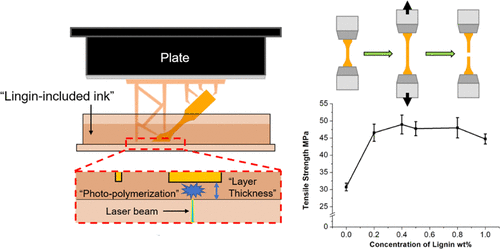Our official English website, www.x-mol.net, welcomes your
feedback! (Note: you will need to create a separate account there.)
Stereolithography 3D Printing of Lignin-Reinforced Composites with Enhanced Mechanical Properties.
ACS Omega ( IF 3.7 ) Pub Date : 2019-11-20 , DOI: 10.1021/acsomega.9b02455 Shuyang Zhang 1 , Mi Li 1, 2 , Naijia Hao 1 , Arthur J Ragauskas 1, 2, 3
ACS Omega ( IF 3.7 ) Pub Date : 2019-11-20 , DOI: 10.1021/acsomega.9b02455 Shuyang Zhang 1 , Mi Li 1, 2 , Naijia Hao 1 , Arthur J Ragauskas 1, 2, 3
Affiliation

|
Due to the availability, biodegradability, and biological effects, lignin has emerged as an interesting alternative to petroleum-based compounds for developing sustainable chemicals, materials, and composites. In this study, lignin at various concentrations was incorporated into methacrylate resin via solution blending to fabricate lignin-reinforced composites using stereolithography apparatus three-dimensional printing. Softwood kraft lignin in the amounts of 0.2, 0.4, 0.5, 0.8, and 1.0 wt % in the methacrylate resin was used as a printing ink, and the gel contents and relative contents of the residual resin in the printed samples with various lignin concentrations were measured. The effects of the lignin on the ultimate mechanical properties of the non-postcured and postcured printed composites were determined. The tensile testing results revealed that the incorporation of lignin in the composite increased the tensile strength by 46-64% and Young's modulus by 13-37% for the postcured printed composites compared with that of the control sample (no lignin added). Employing a 0.4 wt % softwood kraft lignin, the tensile strength of the postcured printed composite reached the highest value of 49.0 MPa, which was a 60% increase in comparison to that of the control sample with 30.7 MPa. Scanning electron microscopy images of the fracture samples illustrated that the lignin-incorporated composites exhibited a rougher fracture surface that can presumably dissipate the stress, which could be a contributing factor for the mechanical enhancement.
中文翻译:

具有增强的机械性能的木质素增强复合材料的立体光刻3D打印。
由于可获得性,可生物降解性和生物效应,木质素已成为石油基化合物开发可持续化学品,材料和复合材料的有趣替代品。在这项研究中,使用立体光刻设备三维印刷,通过溶液共混将各种浓度的木质素掺入甲基丙烯酸酯树脂中,以制造木质素增强的复合材料。使用甲基丙烯酸酯树脂中0.2、0.4、0.5、0.8和1.0 wt%的软木牛皮纸木质素作为印刷油墨,具有不同木质素浓度的印刷样品中的凝胶含量和残留树脂的相对含量分别为测量。确定了木质素对未后固化和后固化印刷复合材料最终机械性能的影响。拉伸测试结果表明,与对照样品(不添加木质素)相比,在复合物中掺入木质素可使后固化印刷复合材料的抗张强度提高46-64%,杨氏模量提高13-37%。采用0.4重量%的软木牛皮纸木质素,后固化的印刷复合材料的拉伸强度达到最高值49.0 MPa,与30.7 MPa的对照样品相比增加了60%。断裂样品的扫描电子显微镜图像显示,掺入木质素的复合材料表现出较粗糙的断裂表面,该表面可能可以消除应力,这可能是机械增强的一个重要因素。与对照样品(未添加木质素)相比,后固化印刷复合材料的s模量提高13-37%。采用0.4重量%的软木牛皮纸木质素,后固化的印刷复合材料的拉伸强度达到最高值49.0 MPa,与30.7 MPa的对照样品相比增加了60%。断裂样品的扫描电子显微镜图像显示,掺入木质素的复合材料表现出较粗糙的断裂表面,该表面可能可以消除应力,这可能是机械增强的一个重要因素。与对照样品(未添加木质素)相比,后固化印刷复合材料的s模量提高13-37%。采用0.4重量%的软木牛皮纸木质素,后固化的印刷复合材料的拉伸强度达到最高值49.0 MPa,与30.7 MPa的对照样品相比增加了60%。断裂样品的扫描电子显微镜图像显示,掺入木质素的复合材料表现出较粗糙的断裂表面,该表面可能可以消除应力,这可能是机械增强的一个重要因素。与30.7 MPa的对照样品相比,增加了60%。断裂样品的扫描电子显微镜图像显示,掺入木质素的复合材料表现出较粗糙的断裂表面,该表面可能可以消除应力,这可能是机械增强的一个重要因素。与30.7 MPa的对照样品相比,增加了60%。断裂样品的扫描电子显微镜图像显示,掺入木质素的复合材料表现出较粗糙的断裂表面,该表面可能可以消除应力,这可能是机械增强的一个重要因素。
更新日期:2019-12-03
中文翻译:

具有增强的机械性能的木质素增强复合材料的立体光刻3D打印。
由于可获得性,可生物降解性和生物效应,木质素已成为石油基化合物开发可持续化学品,材料和复合材料的有趣替代品。在这项研究中,使用立体光刻设备三维印刷,通过溶液共混将各种浓度的木质素掺入甲基丙烯酸酯树脂中,以制造木质素增强的复合材料。使用甲基丙烯酸酯树脂中0.2、0.4、0.5、0.8和1.0 wt%的软木牛皮纸木质素作为印刷油墨,具有不同木质素浓度的印刷样品中的凝胶含量和残留树脂的相对含量分别为测量。确定了木质素对未后固化和后固化印刷复合材料最终机械性能的影响。拉伸测试结果表明,与对照样品(不添加木质素)相比,在复合物中掺入木质素可使后固化印刷复合材料的抗张强度提高46-64%,杨氏模量提高13-37%。采用0.4重量%的软木牛皮纸木质素,后固化的印刷复合材料的拉伸强度达到最高值49.0 MPa,与30.7 MPa的对照样品相比增加了60%。断裂样品的扫描电子显微镜图像显示,掺入木质素的复合材料表现出较粗糙的断裂表面,该表面可能可以消除应力,这可能是机械增强的一个重要因素。与对照样品(未添加木质素)相比,后固化印刷复合材料的s模量提高13-37%。采用0.4重量%的软木牛皮纸木质素,后固化的印刷复合材料的拉伸强度达到最高值49.0 MPa,与30.7 MPa的对照样品相比增加了60%。断裂样品的扫描电子显微镜图像显示,掺入木质素的复合材料表现出较粗糙的断裂表面,该表面可能可以消除应力,这可能是机械增强的一个重要因素。与对照样品(未添加木质素)相比,后固化印刷复合材料的s模量提高13-37%。采用0.4重量%的软木牛皮纸木质素,后固化的印刷复合材料的拉伸强度达到最高值49.0 MPa,与30.7 MPa的对照样品相比增加了60%。断裂样品的扫描电子显微镜图像显示,掺入木质素的复合材料表现出较粗糙的断裂表面,该表面可能可以消除应力,这可能是机械增强的一个重要因素。与30.7 MPa的对照样品相比,增加了60%。断裂样品的扫描电子显微镜图像显示,掺入木质素的复合材料表现出较粗糙的断裂表面,该表面可能可以消除应力,这可能是机械增强的一个重要因素。与30.7 MPa的对照样品相比,增加了60%。断裂样品的扫描电子显微镜图像显示,掺入木质素的复合材料表现出较粗糙的断裂表面,该表面可能可以消除应力,这可能是机械增强的一个重要因素。

































 京公网安备 11010802027423号
京公网安备 11010802027423号